During penetration tests, our primary goal is to identify the difference in paths that can be used to obtain the goal(s) as agreed upon with our customers. This often succeeds due to insufficient hardening, lack of awareness or poor password hygiene. Sometimes we do get access to a resource, but do not have access to the username or password of the user that is logged on. In this case, a solution can be to just ask for credentials in order to increase your access or escalate our privileges throughout the network. This blogpost will go into the details of how the default credential gathering module in a pentesting framework like MetaSploit can be further improved and introduces a new tool that demonstrates these improvements.
Current situation
Let’s say that we have a meterpreter running on our target system but were unable to extract user credentials. Since the meterpreter is not running with sufficient privileges, we also cannot access the part of the memory where the passwords reside. To ask the user for their credentials, we can use a post module to spawn a credential box on the user’s desktop that asks for their credentials. This credential box looks like the one in the image below.
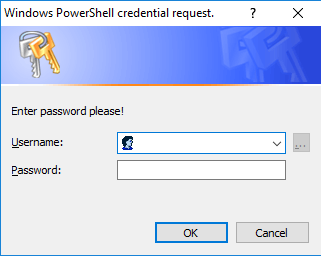
While this often works in practice, a few problems arise with using this technique:
- The style of the input box stems from Windows XP. When newer versions of Windows ask for your credentials, a different type of input box is used;
- The credential box spawns out-of-the-blue. Even though a message and a title can be provided, it does not really look genuine; it misses a scenario where a credential box asking for your credentials can be justified.
A better solution
Because of these issues, this technique will perhaps not work on more security aware users. These users can be interesting targets as well, so we created a new script that solves the aforementioned problems. For creating a realistic scenario, the main approach was: “What would work on us?” The answer to this question must at least entail the following:
- The credential box should be genuine and the same as the one that Windows uses;
- The credential box should not be spawned out-of-the-blue; the user must be persuaded or should expect a credential box;
- If (error) messages are used, the messages should be realistic. Real life examples are even better;
- No or limited visible indications that the scenario is not real.
As a proof of concept, Fox-IT created a tool that uses the following two scenario’s:
- Notifications that stem from an (installed) application;
- System notifications that can be postponed.
With this, the attacker can use his creativity to deceive the user. Below are some examples that were created during the development of this tool:
Outlook lost connection to Microsoft Exchange. In order to reconnect, the user must specify credentials to reestablish connection to Microsoft Exchange.

Spotify subscription will be cancelled at the end of the month. User must provide credentials to renew.
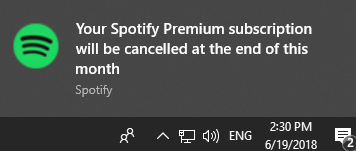
Password that expires within a short period of time.
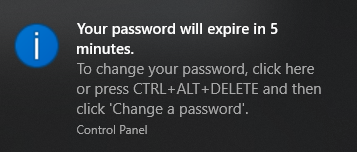
The second scenario imitates notifications from Windows itself, such as pending updates that need to be installed. The notification toast tricks the user into thinking that the updates can be postponed or dismissed. When the user clicks on the notification toast the user will be asked to supply their credentials.
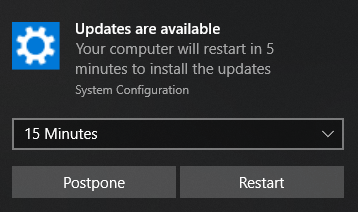
If the user clicks on one of these notifications, the following credential box will pop up. The text of the credential box is fully customizable.
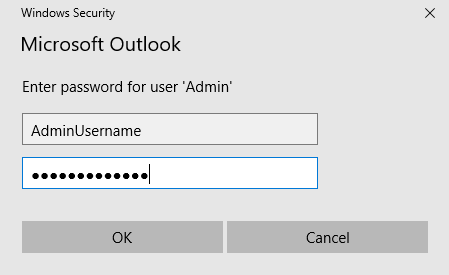
Once the user has submitted their credentials, the result is printed on the console which can be intercepted with a tool of your choosing, such as Cobalt strike. We created an aggressor script for Cobalt Strike that extends the user interface with a variety of phishing options.
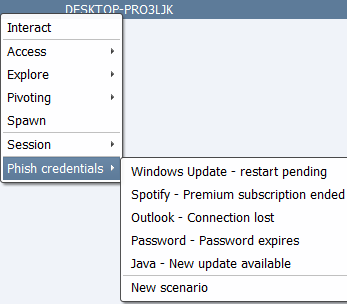
Clicking on one of these options will launch the phishing attack on the remote computer. And if users enter their credentials, the aggressor script will store these in Cobalt Strike as well. The tool as well as the Cobalt Strike aggressor script are available on Fox-IT’s GitHub page: https://github.com/fox-it/Invoke-CredentialPhisher
Technical details
During the development of this tool, there were some hurdles that we needed to take. At first, we created a tool that pops a notification balloon. That worked quite well, however, the originating source of the balloon was mentioned in the balloon as well. It’s not really genuine when Windows Powershell ISE asks for Outlook credentials, so that was not a solution that satisfied us.
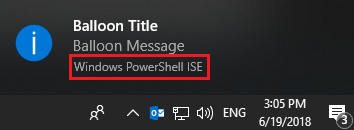
In recent versions of Windows, toast notifications were introduced. These notifications look almost the same as a notification balloon that we used earlier, but work entirely different. By using toast notifications, the problem that the originating source was shown was solved. However, it proved not possible to use event handlers on the toast notifications with native PowerShell. We needed an additional library that acts as a wrapper, which can be found on the following GitHub page: https://github.com/rkeithhill/PoshWinRT
That library solved one part of the issue, but needed to be present on the filesystem of the target computer. That leaves traces of our attack which we do not want, plus, we want to leave the least amount of traces of our malicious code. Therefore, we encoded the library as base64 and stored that in the PowerShell script. The base64 equivalent of the library is evaluated and loaded from memory during runtime and will leave no trace on the filesystem once the tool has been executed. So, now we had a tool capable of sending toast notifications that look genuine. Because of how Windows works, we could also create an extra layer of trust by using an application ID as the source of the notification toast. That way, if you were able to find the corresponding AppID, it looks like the toast notification was issued by the application rather than an attacker.
The notifcation toasts supports the following:
- Custom toast notification title;
- Custom credential box title;
- Custom multiline toast notification message.
To make it more personal, it is possible to use references to attributes that are part of the System.DirectoryServices.AccountManagement.UserPrincipal object. These attributes can be found on the following Technet article: https://msdn.microsoft.com/en-us/library/system.directoryservices.accountmanagement.userprincipal_properties(v=vs.110).aspx. Additionally, the application scenario supports the following extra features when an application name is provided and can be found by the tool:
- AppID lookup for adding extra layer of credibility. If no AppID is found, the tool will default to control panel;
- Extraction of the application icon. The extracted icon will be used in the notification toast;
- If no process is given or the process cannot be found, the tool will extract the information icon from the
C:\Windows\system32\shell32.dlllibrary. By modifying the script, it is easy to incorporate icons from other libraries as well; - Hiding of application processes. All windows will be hidden from the user for extra persuasion. The visibility will be restored once the tool is finished or when the user supplied their credentials.
Cmdline examples
For the examples above, the following onliners were used:
Outlook connection:
.\Invoke-CredentialPhisher.ps1 -ToastTitle "Microsoft Office Outlook" -ToastMessage "Connection to Microsoft Exchange has been lost.`r`nClick here to restore the connection" -Application "Outlook" -credBoxTitle "Microsoft Outlook" -credBoxMessage "Enter password for user ‘{emailaddress|samaccountname}'" -ToastType Application -HideProcesses
Spotify account subsscription:
.\Invoke-CredentialPhisher.ps1 -ToastTitle "Spotify Account Helper" -ToastMessage "Your Spotify Premium subscription will be cancelled at the end of this month" -Application "Spotify" -credBoxTitle "Spotify" -credBoxMessage "Enter your spotify username and password" -ToastType Application
Updates are available:
.\Invoke-CredentialPhisher.ps1 -ToastTitle "Updates are available" -ToastMessage "Your computer will restart in 5 minutes to install the updates" -credBoxTitle "Credentials needed" -credBoxMessage "Please specify your credentials in order to postpone the updates" -ToastType System -Application "System Configuration"
Password expires:
.\Invoke-CredentialPhisher.ps1 -ToastTitle "Consider changing your password" -ToastMessage "Your password will expire in 5 minutes.`r`nTo change your password, click here or press CTRL+ALT+DELETE and then click 'Change a password'." -Application "Control Panel" -credBoxTitle "Windows Password reset" -credBoxMessage "Enter password for user '{samaccountname}'" -ToastType Application
Recommendations
There are no specific recommendations that are applicable to this phishing technique, however, some more generic recommendations are still applicable:
- Check if PowerShell script logging and transcript logging is enabled;
- Raise security awareness;
- Although it is quite hard to distinguish a fake notification toast from a genuine notification toast, users should have a paranoid approach when it comes to processes asking for their credentials.
Article Link: https://blog.fox-it.com/2018/08/14/phishing-ask-and-ye-shall-receive/